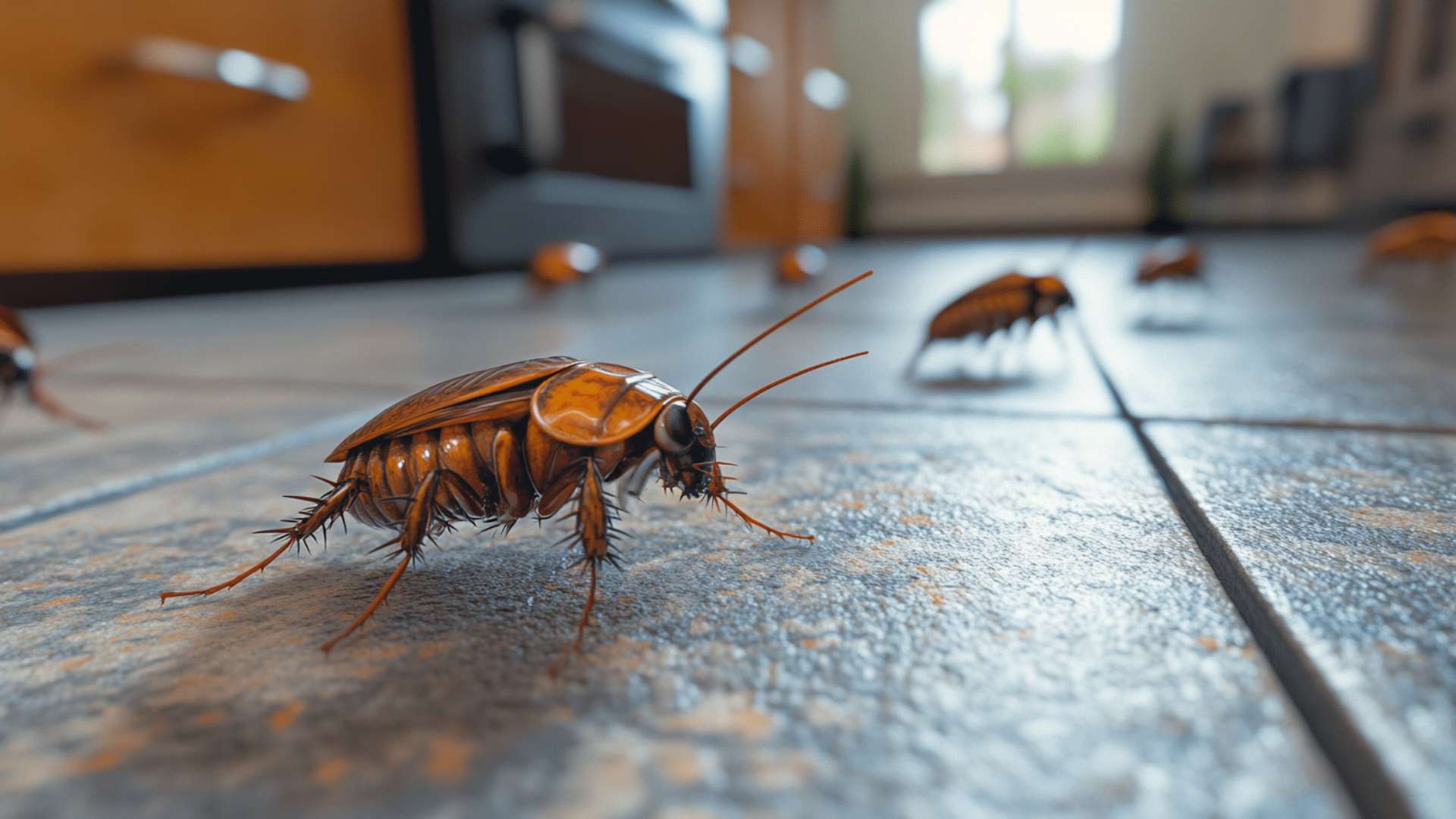When it comes to unwelcome house guests, few creatures can evoke the same level of revulsion as the common cockroach. And in the arid land of Nevada, where water is scarce and temperatures can soar, these pesky insects have found their ideal breeding grounds. From the bustling streets of Las Vegas to the quiet neighborhoods in the Las Vegas Valley, cockroaches have managed to infiltrate homes across the state.
Nevada is home to several species of cockroaches that adapt remarkably well to its unique environment. These insect invaders are not limited to one specific type or size; rather, they come in various forms.
Some may be light brown and small like Australian cockroaches, while others may be larger and darker like American or German cockroaches. These pests often thrive in dark areas such as crawl spaces and corners within households.
Explore Our Professional Roach Management and Extermination Services! Learn how our skilled roach control and extermination solutions can effectively address your Roach Infestation Signs and Detection!
Importance of understanding their habits and characteristics

While it may seem tempting to turn a blind eye to these creepy crawlies, understanding their habits and characteristics is crucial for effective pest control. Cockroaches are not merely an unsightly nuisance; they pose serious health risks by spreading diseases and triggering allergies. Their ability to infest large amounts of household items further emphasizes why it’s important not only to eliminate them but also prevent their return.
By delving into the world of these resilient insects, we can uncover ways to combat them effectively. Knowing their preferred habitats and behavior patterns equips homeowners with valuable knowledge about how best to protect themselves from infestations.
With this knowledge, individuals can implement preventative measures that range from sealing entry points into homes to maintaining cleanliness standards that discourage roach populations from taking hold. As we delve deeper into this article, we will explore different species found in Nevada, their lifecycles, adaptations for survival, potential health risks they pose, and prevention techniques.
By gaining a comprehensive understanding of Nevada cockroaches, we can arm ourselves with the knowledge necessary to combat these dangerous pests and ensure our homes remain roach-free sanctuaries. After all, in the battle against these resilient invaders, knowledge is power.
Types of Cockroaches Found in Nevada
American Cockroach (Periplaneta americana)
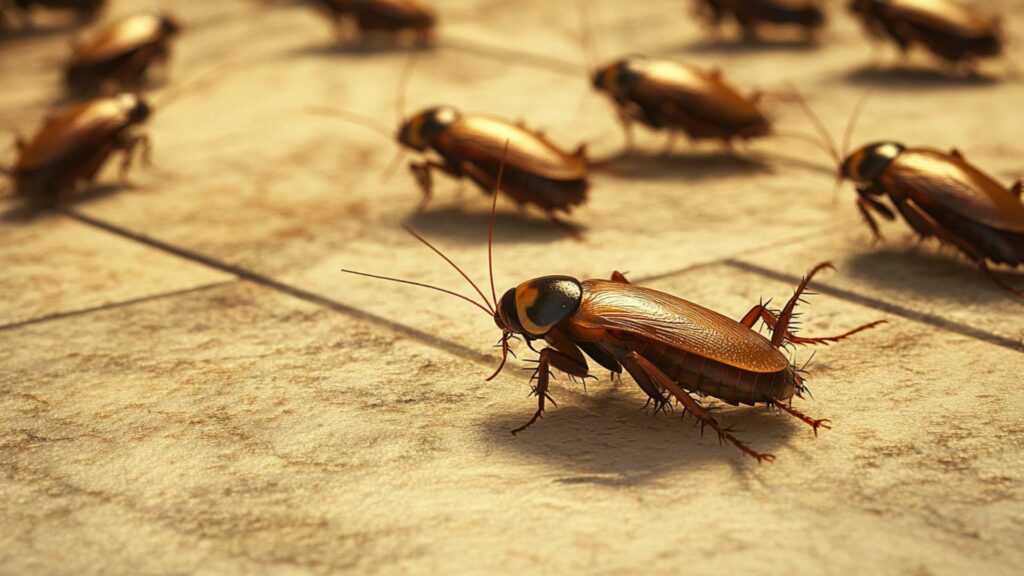
The American cockroach, scientifically known as Periplaneta Americana, is one of the most common species of cockroaches found in Nevada. These resilient insects are easily recognizable due to their large size, measuring up to two full inches long in length.
One of the key distinguishing features of the American cockroach is its reddish-brown color and long antennae that protrude from its head. Additionally, they have two dark stripes on their pronotum, which is the shield-like structure behind their heads.
American cockroaches have a preference for warm and humid areas, making Nevada’s climate ideal for their survival. They can be found in various habitats across the state, including residential areas, commercial buildings, restaurants, and even sewer systems.
In urban settings like Las Vegas Valley, these roaches are commonly found scurrying around garbage cans or near drainage areas. They are also often discovered near palm trees due to the moist conditions created by water accumulation at their base.
German Cockroach (Blattella germanica)
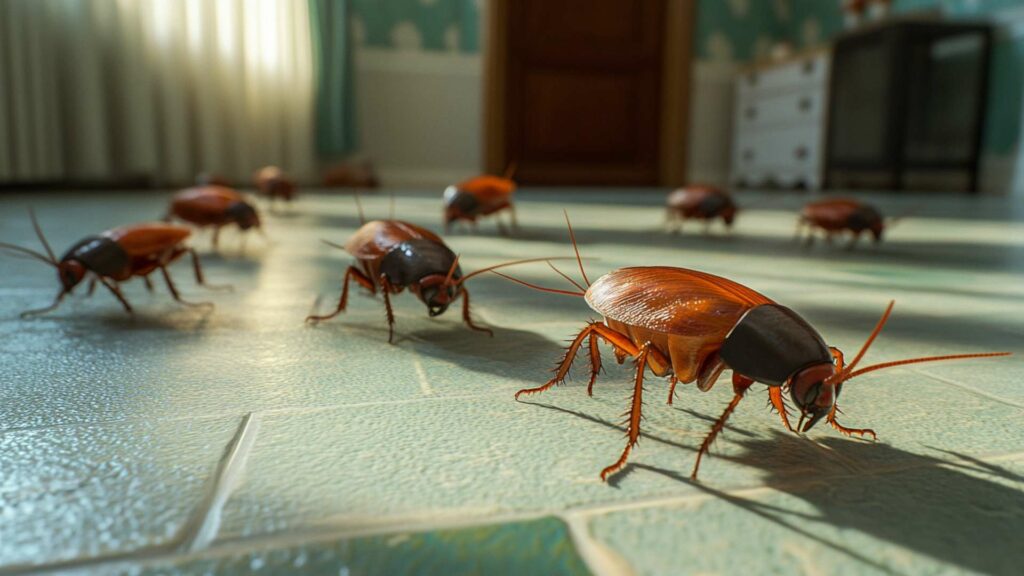
The German cockroach (Blattella germanica) is another prevalent species that contributes to Nevada’s cockroach problem. Unlike its larger American counterpart, German cockroaches are relatively smaller in size and typically measure around half an inch long. They possess light brown or tan bodies with two parallel dark stripes running down their backs.
One of the unique traits of German cockroaches is their remarkable ability to thrive in extreme conditions. These pests can reproduce rapidly and adapt quickly to changing environments—making them difficult to eradicate once they establish a presence within a property.
In Nevada, they frequently infest homes and businesses where food sources are abundant and easily accessible. Kitchens and bathrooms tend to be favorite hotspots for German cockroaches, as they are attracted to moist areas and have a particular affinity for fatty foods.
Oriental Cockroach (Blatta orientalis)
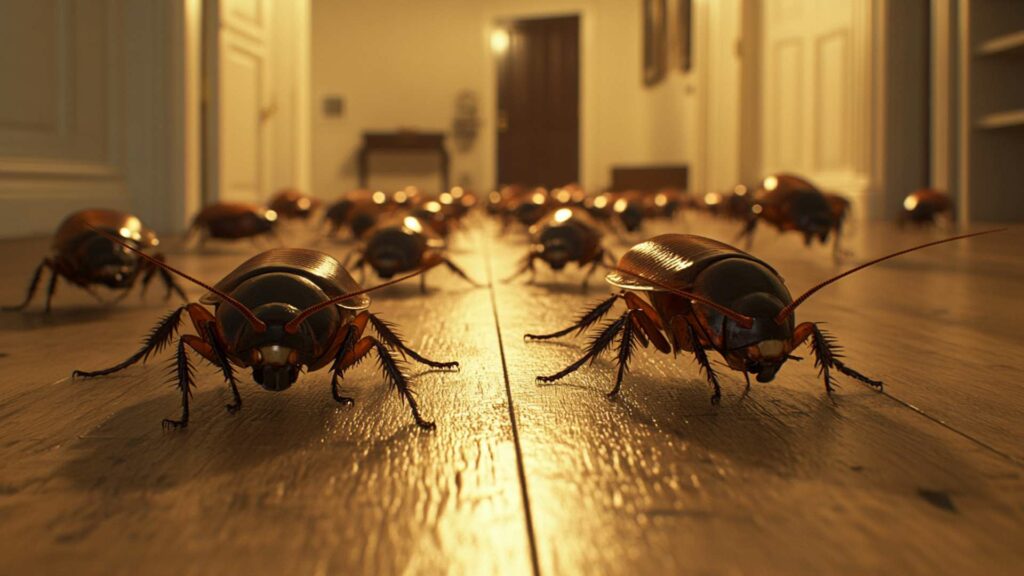
The Oriental cockroach (Blatta orientalis), commonly found in the Middle East, has also made its way into Nevada. What sets them apart from other species is their dark brown or black coloration and their inability to fly. Oriental cockroaches have short wings that do not allow them to take flight, which contrasts with other roach species capable of flying short distances.
Oriental cockroaches have a preference for cool and damp environments. In Nevada, these insects can be found in areas that provide moisture, such as basements, crawl spaces, and sewers.
They are frequently spotted in residential neighborhoods around decaying vegetation or under piles of leaves. Unlike German cockroaches, Oriental cockroaches do not rely on fatty foods but can consume various organic materials found in their chosen habitats.
By understanding the characteristics and habitats of these three common species—American, German, and Oriental cockroaches—Nevada residents can better identify potential infestation areas within their homes or businesses. Being aware of the specific traits associated with an infestation of each species enables targeted prevention measures and effective pest management strategies tailored to combat these resilient insects.
Lifecycle and Behavior of Nevada Cockroaches
Egg Stage: Development, Incubation Period, and Hatching Process
During the egg stage of Nevada cockroaches, the process of development and incubation takes place. Female cockroaches lay their eggs in concealed areas such as cracks, crevices, or other hidden spots within your Las Vegas home.
The eggs are dark reddish brown and shaped like a small capsule. Each female can produce hundreds of eggs throughout her lifetime.
The incubation period for cockroach eggs depends on factors such as temperature and humidity. In warm environments like the Las Vegas area, where temperatures are typically high, the incubation period is shorter.
It can range from a few weeks to a couple of months. As the eggs develop, you may notice a slight change in color.
Once the incubation period is complete, tiny nymphs emerge from the eggs. These nymphs go through several molting stages before reaching adulthood.
Nymph Stage: Growth, Molting, and Transformation into Adults
After hatching from their eggs, Nevada cockroaches enter the nymph stage of their life cycle. Nymphs are smaller versions of adult roaches but lack fully developed wings and legs. They have soft exoskeletons that gradually harden as they grow.
As nymphs grow in size during successive molts—shedding their old exoskeleton—they resemble miniature versions of adults with each molt. The number of molts varies among species but typically ranges from 5 to 13 times until they reach adulthood.
The transformation from nymph to adult is accompanied by significant changes in appearance and physical characteristics. During this stage, wings fully develop (if applicable to the species) and sexual organs mature.
Adult Stage: Reproduction, Lifespan, and Survival Strategies
Once Nevada cockroaches reach adulthood, they become capable of reproduction. Adult cockroaches have distinct physical features that aid in species identification.
For example, German cockroaches have light brown bodies with two dark stripes running lengthwise behind their heads. Reproduction rates vary among species, but generally, adult females produce egg cases known as oothecae.
Each ootheca contains multiple eggs and is typically dropped or attached to a hidden surface in your Las Vegas home. The lifespan of adult cockroaches varies depending on factors like environmental conditions and available food sources.
On average, they live for several months to over a year. During this time, they employ various survival strategies such as nocturnal activity to avoid predators and locate food sources.
Understanding the lifecycle and behavior of Nevada cockroaches is crucial when dealing with a serious cockroach infestation problem in your Las Vegas home or the surrounding area. By familiarizing yourself with their stages of development, you can better implement pest control measures and take proactive steps to prevent infestations from occurring or recurring.
Adaptations for Survival in the Nevada Environment
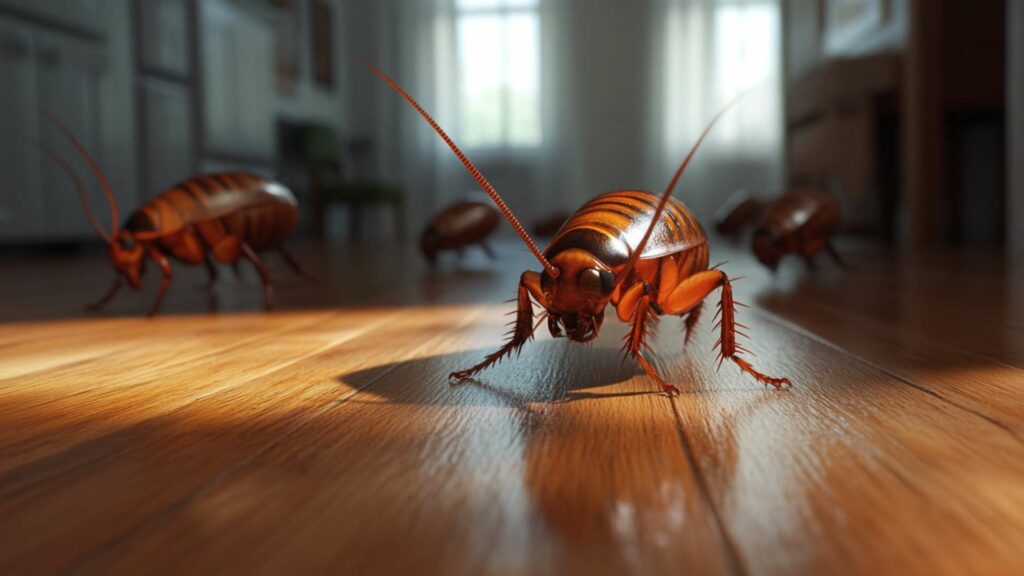
Nevada’s desert climate is known for its scorching hot summers and chilly winters. It may come as a surprise, but cockroaches have remarkable adaptations that allow them to survive in such extreme conditions.
One of the most resilient species found in Nevada is the American cockroach. These robust creatures can tolerate temperatures ranging from freezing cold to sweltering heat.
Their exoskeleton acts as an insulating layer, protecting them from dehydration and temperature fluctuations. Additionally, their ability to regulate water loss through their cuticle helps them endure arid conditions.
In a desert environment like Nevada, water is scarce and precious. Cockroaches have evolved to adapt and seek out dark and damp areas where moisture can be retained for longer periods.
Commonly found near leaky pipes or crawl spaces, these pests actively look for environments that offer humidity and shelter from the intense heat of the desert sun. Additionally, they are drawn towards areas with organic matter that can provide sustenance while also retaining moisture.
Cockroaches are opportunistic feeders with a remarkably broad diet that allows them to survive even when food sources are limited in the Nevada desert. American cockroaches, one of the most common species found in Las Vegas homes and establishments, have voracious appetites. They are known to consume almost anything: from leftover human food such as fatty foods or fermenting foods hidden away in kitchen crevices, to decaying plant matter or even other insects when desperate for sustenance.
Their adaptability extends not only to different types of organic materials but also their ability to digest them. Cockroaches possess powerful enzymes in their gut that can break down complex compounds, such as cellulose found in plant matter.
This adaptability and resilience when it comes to food sources make them remarkably successful survivors in the harsh Nevada environment. With these adaptations, cockroaches have managed to carve a niche for themselves in the challenging Nevada landscape.
Their ability to withstand extreme temperatures, preference for dark and damp habitats, and versatile feeding habits allow them to thrive despite limited water sources and fluctuating food availability. Understanding these adaptations is crucial in devising effective strategies for preventing and controlling cockroach infestations in homes and businesses across Nevada.
Allergies Caused by Cockroach Allergens

When it comes to cockroaches, allergies are not uncommon. These resilient creatures produce allergens that can trigger reactions in sensitive individuals. The proteins found in their saliva, droppings, and discarded exoskeletons are the main culprits behind these allergic reactions in humans.
People who already suffer from asthma or respiratory issues are particularly susceptible to these allergens. The presence of cockroach allergens can lead to a range of symptoms including sneezing, coughing, itchy eyes, nasal congestion, and even skin rashes.
In severe cases, individuals may experience difficulty in breathing or asthma attacks. It’s important to note that even dead cockroaches can still cause allergic reactions as their bodies decompose and release allergenic particles into the air.
Diseases Transmitted by Cockroaches

Cockroaches aren’t just unsightly pests; they also pose significant health risks due to their potential for spreading diseases. These disease carriers can transfer bacteria such as Salmonella and E.coli onto surfaces they come into contact with.
When cockroaches crawl across food preparation areas or utensils, they leave behind these harmful bacteria which can contaminate our food and water sources. Furthermore, cockroaches are known vectors for various pathogens that cause diseases such as dysentery, typhoid fever, cholera, and gastroenteritis.
They can easily pick up microorganisms while scavenging in unsanitary areas like sewers or garbage bins. Once inside our homes or businesses, they transfer these harmful bacteria onto surfaces we frequently touch.
Damage Caused to Structures, Food Sources, and Belongings
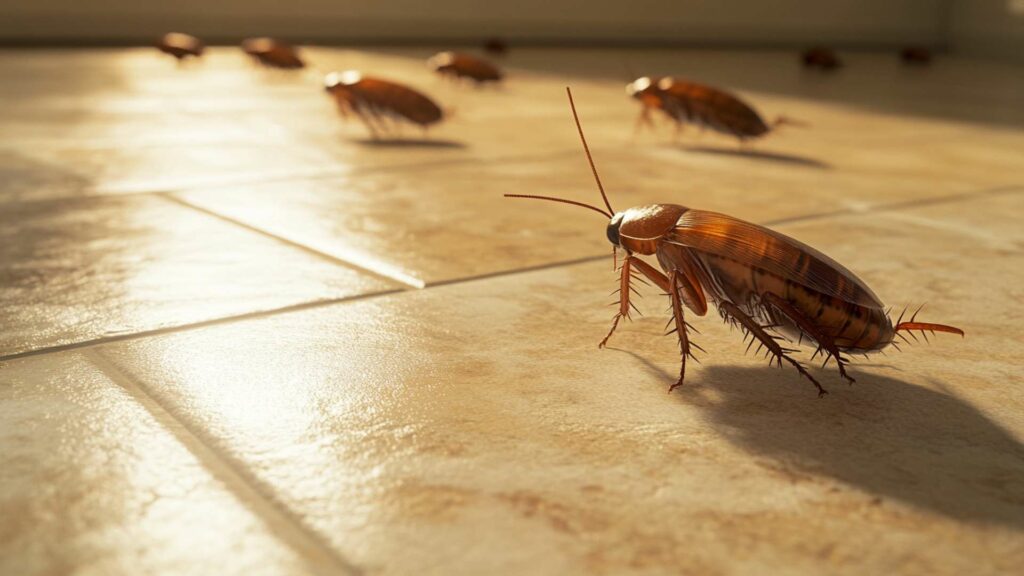
Cockroaches aren’t just a nuisance; they can also wreak havoc on our properties. Their constant gnawing and chewing can cause damage to structures, furniture, books, and even electrical wiring.
This chewing behavior is not only destructive but can also pose fire hazards if the damaged wires are left unnoticed. Food sources are not spared either.
Cockroaches contaminate food with their droppings, saliva, and body parts, making it unsafe for consumption. They have a particular affinity for starchy and sugary substances, including cereals, grains, and crumbs.
In addition to contaminating food items directly, their presence can attract other pests such as roof rats that feed on cockroaches. Cockroaches in Nevada have the potential to negatively impact both human health and property.
From triggering allergies through allergens released by cockroaches to spreading diseases via their movement across surfaces where we prepare our meals and eat our food – the risks they pose should not be underestimated. Furthermore, the damage they cause to structures and belongings can be costly to repair or replace.
Given these concerns, effective pest control measures become essential in maintaining a healthy environment free from these common household pests. (Note: This creative writing piece is intended solely for entertainment purposes)
Prevention Techniques for Controlling Cockroach Infestations
A Spotless Environment Keeps Roaches Away! When it comes to keeping a roach-free environment, cleanliness is your most powerful weapon.
Cockroaches are attracted to food residues, crumbs, and other organic matter they can feast on. By keeping your home meticulously clean, you create an inhospitable environment for these pests.
Start by regularly sweeping or vacuuming your floors to remove any food debris. Pay special attention to areas around appliances, crevices, and corners where roaches often hide.
Additionally, wipe down kitchen countertops with disinfectant regularly and don’t forget about the sink! Remember that cockroaches can survive on even the smallest amounts of water.
Fix any leaky pipes or faucets promptly and ensure no standing water accumulates in or around your home. By eliminating their water sources, you make it harder for them to survive.
Locking the Doors of Your Home Against Unwanted Guests Even the tiniest cracks or gaps in your home’s structure can serve as inviting entry points for cockroaches. Inspect your windowsills, doors, vents, and foundation for any potential openings that might allow these critters inside.
Seal off gaps using weather-stripping and caulk to create a barrier against unwanted intruders. Installing door sweeps will prevent roaches from sneaking underneath doors while mesh screens over windows provide an added layer of protection without compromising ventilation.
It’s also worth mentioning that vegetation near your house can attract cockroaches. Trim back tree branches that touch your roof or walls as this gives them easy access into your home.
Out of Sight, Out of Reach for Roaches! Cockroaches have a knack for locating food sources, even if they’re well-hidden. To prevent a potential cockroach problem, it’s crucial to store your food properly.
Keep all food containers tightly sealed to deny roaches access to their favorite snacks. Opt for airtight containers made from glass or plastic to ensure maximum effectiveness.
Avoid leaving uneaten pet food out overnight as it can also attract these unwanted visitors. When it comes to waste management, make sure your trash cans have secure lids and are emptied regularly.
Keep them away from the immediate vicinity of your home, preferably in sealed bins outside. This will help prevent cockroaches from being lured by the scent of discarded food.
Conclusion
In the battle against cockroach infestations, prevention is key! By implementing simple yet effective techniques like maintaining cleanliness and hygiene practices, sealing entry points into your home, and proper storage of food and waste, you can significantly reduce the risk of encountering these resilient pests. Remember that even under extreme conditions such as those found in the arid Las Vegas area, common cockroaches can find ways to survive.
However, with consistent efforts in keeping your surroundings clean and fortified against their intrusion, you can enjoy a roach-free environment. So take charge today!
Implement these preventative measures and reclaim control over your living space. By doing so, you’ll not only safeguard against cockroach invasions but also create an environment that promotes overall health and well-being for you and your loved ones.
Choose D-Termination: Las Vegas’ Premier Pest Control, for cockroach elimination!

Are you grappling with cockroach problems? D-Termination is here to provide assistance. Our skilled team specializes in eradicating cockroach infestations, ensuring hygiene and peace of mind are restored. Bid farewell to cockroaches—opt for D-Termination’s effective pest control today!
To book your cockroach control service and reclaim your space from these resilient pests, contact us at 702-919-6310 or visit dtermination.com.
Frequently Asked Questions:
Various cockroach species are found in Nevada, including German and American cockroaches.
The German cockroach is the most common roach species in Las Vegas.
Yes, roaches are common in Nevada, especially in urban areas.
Cockroaches in Nevada vary in appearance depending on the species but generally have flattened bodies and antennae.

